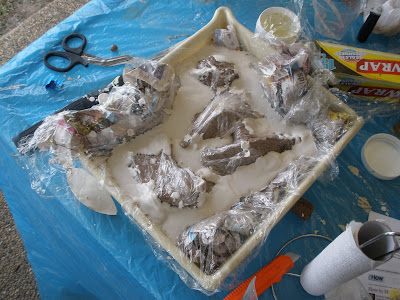
Exciting Happenings went on over the easter break. Our group congregated together under the auspices of the Architecture Model fabrication Convention, or AMfC. Therein we decided that the primary technique of "casting" would be the closest match to the sensibilities which we were developing in our drawings of the design. The casting technique allowed us to explore our group's cave-like design in a haptic three dimensional sense, which was sorely lacking until up to this point. Casting the models provided the opportunity to develop and resolve the clarity of the form and structure of the room.
here is a link to my photobucket profile which contains all the photos taken over our 2-day conference:
I would like to explain a few key points of my own reflection on the success of the task.
First, the process was quite a unique experience in that for casting, careful consideration and planning needs to be carried out before things are set in motion to be "constructed". Essentially with casting, you are constantly working between positive and negative - void and solid, so that mould assemblages are opposite to the cast object within that mould.

We experimented with what we could use as moulds for the casts - such as plastic bags filled with bark, cling wrap over newspaper, empty bottles and clay. All of these gave different effects of texture and structure to the casts.

Creating a cave-like environment, we had made decisions to obstruct any views from inside the room to the outside. This however, meant that the experience of the weight and density of the surrounding shell could not be architecturally controlled, but instead up to the unpredictable opinion of the observer. So with our cast models, we paid carefull attention to adressing this key experiential aspect to our design by way of modulating the thickness of material along the walls, having holes, folds and slits slice sections through, and even - in the case of the wax cast - where modulation in material density could actually permit a dull luminance through by being ever so slightly transparent.

The Architecture Model fabrication Convention was a very worthwhile experience which I shall endeavour to apply to my design work from now on.

No comments:
Post a Comment